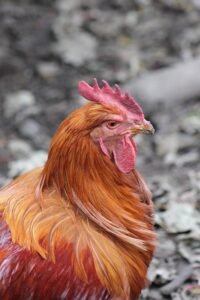If you’re raising chickens, you’ve probably noticed something peculiar around certain times of the year—your chickens look a bit… well, scruffy. Fear not! They’re not falling apart, they’re molting. Molting is a completely natural process that every chicken goes through. It’s like a wardrobe refresh for them—out with the old feathers, in with the new (and fabulous). Let’s break down everything you need to know about molting and feather care in chickens and how to keep your flock happy and healthy during this season of transformation.
Molting Basics
Molting is your chicken’s way of maintaining their glorious plumage. Simply put, it’s the process of shedding old, worn-out feathers and growing new ones. Think of it as a spa day… okay, more like a spa month.
Why Do Chickens Molt?
Molting serves multiple purposes, including:
- Natural Feather Replacement: Feathers wear out over time, losing their ability to provide insulation and waterproofing. Molting keeps chickens cozy and sleek.
- Body Maintenance: It’s a health upgrade for your birds. Fresh feathers mean better protection against the elements.
- Seasonal Adaptation: Chickens often molt in late summer or early fall to prepare for the colder months.
Types of Molts
Chickens have a few different types of molts. Here’s the breakdown:
- Juvenile Molt (baby fluff to big-kid feathers)
- Annual Molt (the most common)
- Stress Molt (caused by sudden changes or stressors—hello, loud neighbors!)
- Force Molt (a questionable practice often associated with commercial farming, not recommended for backyard flocks)
Molting Timeline
- First Molt generally happens when they’re about 18 months old.
- It typically lasts 8–12 weeks but can vary by chicken.
- Chickens most commonly molt in the fall after laying eggs throughout the summer.
But don’t panic if your flock looks like they joined a feather-shedding contest. A scraggly bird is a molting bird.
Feather Structure and Function
Feathers aren’t just about looking fancy—they’re powerhouses of functionality, and every part serves a purpose.
Anatomy of Feathers
Each feather is made up of:
- Shaft (the central “stem” of the feather)
- Barbs and Barbules (the tiny hooks that keep the feather smooth and structured)
- Down Feather Base (soft and fluffy, perfect for trap heat)
Types of Feathers
- Flight Feathers for gliding across the yard (or attempting short, hilarious, chicken-style hops)
- Contour Feathers for body shape and waterproofing
- Down Feathers for insulation and warmth
- Semi-Plumes for a little extra fluff and aerodynamics
Why Healthy Feathers Matter
Feathers aren’t just for show—they provide insulation, protection, and even assist in social displays (hello, rooster strut). Your chickens’ overall health is directly linked to the care of their plumage.
The Molting Process
Confused about why the pattern of feather loss looks so random? There’s actually a method to the madness.
Sequence of Feather Loss
- Head and Neck (cue the scruffy look)
- Back and Breast
- Wings
- Tail Feathers
Physical Changes
Be prepared to see some changes in your birds, like exposed skin and a slightly “off” look. You might also notice minor weight fluctuations or extra sensitivity.
Behavioral Changes
Molting takes energy! Chickens may become a bit lethargic, less social, and even reduce their food intake. They’re not upset with you—just busy channeling all their energy into growing those fabulous new feathers.
Nutritional Needs During Molt
Here’s where you come in, feather-fairy godparent. Chickens require extra TLC during molt, especially when it comes to diet.
Protein Is Key
Feathers are 85% protein, so your chickens’ diet needs a serious dose of it.
- Offer high-protein snacks like mealworms, scrambled eggs, or sunflower seeds.
- Consider a molting-specific feed available at your local farm supply.
Minerals and Vitamins
- Calcium is still vital, especially for hens that continue to lay eggs. Include oyster shells as a calcium supplement.
- Add greens like spinach or vitamins like biotin to boost feather quality.
Environmental Management
A stress-free coop = happier molting chickens.
Temp and Lighting Matters
- Keep the coop draft-free and maintain an ideal temperature (even during seasonal shifts).
- If light impacts molting patterns, consider installing low-intensity artificial lights as the days get shorter.
Comfort Zones
- Extra space helps reduce competition while your chickens are potentially cranky and molting.
- Include cozy, separate areas for the shyer birds.
Molting and Production Impacts
Molting can bring some changes to egg production and even meat quality.
- Egg Laying slows down or stops entirely during molt. Don’t worry; this is temporary! They’ll start laying again as their feathers finish regrowing.
- Meat Chickens may show slight weight loss due to redirected energy toward feather growth, but this doesn’t typically alter meat quality.
Feather Care & Long-Term Health
Once the molt wraps up, help your chickens maintain their new feathers by:
- Encouraging regular dust baths to prevent pests
- Providing enrichment areas like perches or scratching posts
- Keeping up with weekly feather and skin inspections.
Special Considerations
Lastly, every chicken is unique. Age, breed, and even climate affect molting patterns.
- Older chickens may take longer than youngsters to complete their molt.
- Bantams and heavy breeds like Brahmas may require a little more warmth.
Keep Calm and Care for Molting Chickens
Molting isn’t a chicken crisis—it’s a beauty reset! By understanding their nutritional needs, environmental preferences, and natural timeline, you can help your flock transition smoothly into their new feather outfits. Pay attention to their comfort and enjoy watching the transformation—they’ll thank you with fresh feathers and, soon enough, some tasty eggs.
Now that you’ve mastered the art of molting care, why not share your success stories and tips with fellow enthusiasts? Or better yet, treat your flock to their favorite high-protein snacks and watch the magic of nature take its course.
For More on Chicken Care check out one of my articles:
Chicken Foraging and Free Ranging
Best Chicken Breeds for Egg Laying
Safely Introducing New Hens to Your Flock

